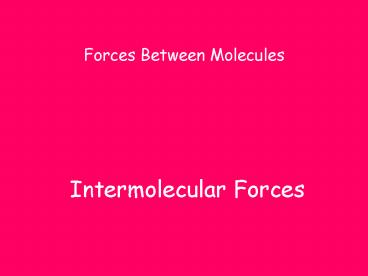Intermolecular Forces - PowerPoint PPT Presentation
Title:
Intermolecular Forces
Description:
Forces Between Molecules Intermolecular Forces What happens to the boiling point when the external pressure is reduced? The boiling point is reduced. – PowerPoint PPT presentation
Number of Views:120
Avg rating:3.0/5.0
Title: Intermolecular Forces
1
Intermolecular Forces
- Forces Between Molecules
2
Why are intermolecular forces important?
- They determine the phase of a substance at room
temperature.
3
3 Types of Intermolecular Forces
- Dispersion or Van der Waals
- Dipole-dipole
- Hydrogen Bonds
4
Strongest Intermolecular Force
- Hydrogen Bonds
5
When do Hydrogen bonds occur?
- Between molecules containing F, O, N bonded to a
H atom
6
Strongest hydrogen bonds?
- Between molecules containing F-H bonds
7
Weakest hydrogen bonds?
- Between molecules containing N-H bonds
8
What effect does H-bonding have on the properties
of the substance?
- Hydrogen bonding leads to substantial increases
in the expected boiling point.
9
Weakest Intermolecular Force
- Dispersion or Van der Waals forces
10
When do dispersion forces occur?
- Between nonpolar molecules
11
Nonpolar
- No Poles!
- The molecule is symmetric!
- Cannot tell 1 end from the other.
- (Kickballs footballs)
12
2 Easy categories of Nonpolar Molecules
- Monatomic Gases (Column 18)
- Diatomic Elements
13
What are the diatomic elements?
- H2, N2, O2, F2, Br2, Cl2, I2
14
3rd category of Nonpolar Molecules
- Larger molecules with a very symmetric shape
15
What can you say about dispersion forces as a
function of molecular size?
- The larger the molecules the stronger the
dispersion forces!
16
When do dipole-dipole forces occur?
- Between polar molecules.
17
Polar
- Has Poles!
- The molecule is NOT symmetric!
- Can tell 1 end from the other.
18
Vapor
- Gas phase of a substance that is normally a
liquid at room temperature.
19
Vapor Pressure
- The partial pressure of a vapor above its liquid.
20
What does vapor pressure depend on? (Hint see
Table H)
- Vapor pressure depends on the temperature of the
liquid.
21
What happens to the vapor pressure as the
temperature of the liquid is increased?
- The vapor pressure always increases with
temperature.
22
Does the vapor pressure depend on the amount of
liquid present?
- No. A thimbleful is as good as an ocean.
23
What are some differences between evaporation
boiling?
- Evaporation occurs at all temperatures. Boiling
occurs at a definite temperature. - Evaporation occurs at the surface. Boiling
occurs throughout the liquid.
24
Heat of fusion
- Amount of energy required to convert 1 gram of a
pure solid to the liquid phase at its melting
point.
25
Heat of vaporization
- Amount of energy required to convert 1 gram of a
pure liquid to the gas phase at its boiling point.
26
What happens to the boiling point as the
intermolecular forces increase?
- The stronger the intermolecular forces, the
higher the boiling point.
27
What happens to the melting point as the
intermolecular forces increase?
- The stronger the intermolecular forces, the
higher the melting point.
28
What happens to the heat of fusion as the
intermolecular forces increase?
- The stronger the intermolecular forces, the
higher the heat of fusion.
29
What happens to the heat of vaporization as the
intermolecular forces increase?
- The stronger the intermolecular forces, the
higher the heat of vaporization.
30
What happens to the evaporation rate as the
intermolecular forces increase?
- The stronger the intermolecular forces, the lower
the evaporation rate.
31
What happens to the vapor pressure as the
intermolecular forces increase?
- The stronger the intermolecular forces, the lower
the vapor pressure.
32
Boiling Point
- Temperature at which the vapor pressure of a
liquid is equal to the external pressure.
33
Normal Boiling Point
- Temperature at which the vapor pressure of a
liquid is equal to 1 atm or 101.3 kPa or 760 torr.
34
What happens to the boiling point when the
external pressure is reduced?
- The boiling point is reduced.
35
Sublimation
- Solid to gas
36
Deposition
- Gas to solid
37
Vaporization
- Liquid to Gas
38
Condensation
- Gas to liquid
39
Fusion
- Solid to liquid
- Or
- Melting
40
Freezing
- Liquid to solid
- Crystallization
- Solidification
41
Which phase changes are endothermic?
G L S
- Solid to liquid
- Liquid to Gas
- Solid to Gas
42
Which phase changes are exothermic?
- Gas to Liquid
- Liquid to Solid
- Gas to Solid
G L S
43
Given 3 substances at room temperature 1 solid,
1 liquid, 1 gas, which has the strongest
intermolecular forces?
- Solid gt Liquid gt Gas
44
Describe the mp bp of gases.
- Low!
45
H?F
--------
H?F
Hydrogen Bonding!
46
Ne
--------
Ne
Van der Waals or dispersion forces
47
HCl
--------
HCl
Dipole-dipole forces
48
H
H
-
-
H-N
--------
---------
H
-
--------
H-F
O
-
H
Hydrogen Bonding































